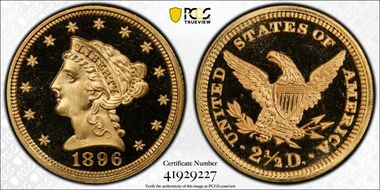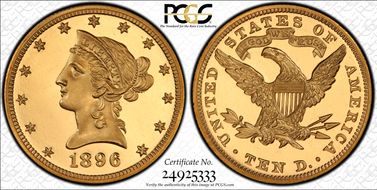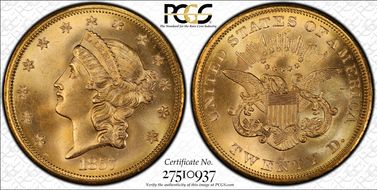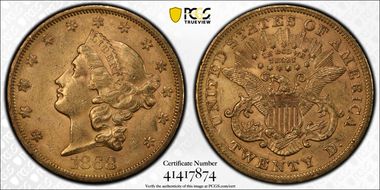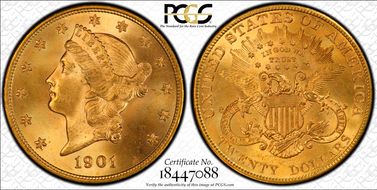The Gypsy Collection 的钱币相册
CAC. While the official mintage of 78 proof 1896 ten dollar coins might suggest that the date is relatively available, circumstantial evidence suggests that that output was an overreach. Not only were mintages of proof eagles lower in the next two years (69 and 67 pieces, respectively), but the estimated survival of the 1896 ten dollar proofs is close to that of the 1897, with the 1898 pieces seeing a spike in the survival rate despite a slipping mintage. PCGS suggests that 35 to 45 specimens survive for the 1896 and 1897 dates, compared to "40 to 50 known" for the 1898 issue. The PCGS Population Report lists 25 certification events for the 1896 ten dollar proof, 16 with Cameo contrast and nine labeled Deep Cameo. (It should be remembered that the period from 1896 to 1898 was a high-water mark for the cameo effect in U.S. silver and gold proof coinage.) A majority of the coins are in the PR64 range; among Deep Cameo pieces, this is one of just two certified by PCGS with three numerically finer as Deep Cameo, all graded PR66 (2/12). Effectively black-and-gold contrast is on display with this Deep Cameo Gem, thanks to sharply struck, thickly frosted devices paired with fields that combine so-called "orange-peel" texture with a great overall mirror finish. A thin, curving blemish just off the bridge of Liberty's nose and a depression to the left of star 9 are the most reliable pedigree markers. (Upgrade from 65). PCGS 65DCAM 2/3 (02/12) PCGS 65+DCAM 1/15 (05/15)
CAC. While the official mintage of 78 proof 1896 ten dollar coins might suggest that the date is relatively available, circumstantial evidence suggests that that output was an overreach. Not only were mintages of proof eagles lower in the next two years (69 and 67 pieces, respectively), but the estimated survival of the 1896 ten dollar proofs is close to that of the 1897, with the 1898 pieces seeing a spike in the survival rate despite a slipping mintage. PCGS suggests that 35 to 45 specimens survive for the 1896 and 1897 dates, compared to "40 to 50 known" for the 1898 issue. The PCGS Population Report lists 25 certification events for the 1896 ten dollar proof, 16 with Cameo contrast and nine labeled Deep Cameo. (It should be remembered that the period from 1896 to 1898 was a high-water mark for the cameo effect in U.S. silver and gold proof coinage.) A majority of the coins are in the PR64 range; among Deep Cameo pieces, this is one of just two certified by PCGS with three numerically finer as Deep Cameo, all graded PR66 (2/12). Effectively black-and-gold contrast is on display with this Deep Cameo Gem, thanks to sharply struck, thickly frosted devices paired with fields that combine so-called "orange-peel" texture with a great overall mirror finish. A thin, curving blemish just off the bridge of Liberty's nose and a depression to the left of star 9 are the most reliable pedigree markers. (Upgrade from 65). PCGS 65DCAM 2/3 (02/12) PCGS 65+DCAM 1/15 (05/15)
CAC. Spiked Shield, Variety 20A. Ex: S.S. Central America. SSCA 2796. The Central America went from being an almost-forgotten maritime disaster to an oft-told treasure tale after the discovery of the wreck -- and the golden cargo within. This Premium Gem 1857-S double eagle was one of thousands packed tightly together on the ship and bound for New York with who-knows-what eventual fate when a hurricane sank the Central America. After more than a century and a quarter, this coin and its fellows changed collector understanding of the 1857-S double eagle forever. Despite being packed for shipping, riding through two rough oceans, sinking in a hurricane, and being raised from the ocean floor, this Premium Gem has come through hardly the worse for events (and obviously with no wear). Canary-gold luster, bright and pale, deepens slightly toward the rims. A tiny mark along Liberty's chin is well within the bounds of the grade. Offered alone (no box or paperwork), but this coin and its gold-insert holder carry their own credentials. From The Richard P. Ariagno, M.D. Collection
CAC. Purchased as MS65/CAC, upgraded to MS66/CAC, this elegant Gem survivor from this turn-of-the-century issue is sharply struck with vibrantly lustrous wheat-gold and mint-green surfaces and marvelous visual appeal. The portrait is especially clean, with only a handful of minuscule luster grazes away from the focal points. PCGS 4/0 (5/15)
CAC. Purchased as MS65/CAC, upgraded to MS66/CAC, this elegant Gem survivor from this turn-of-the-century issue is sharply struck with vibrantly lustrous wheat-gold and mint-green surfaces and marvelous visual appeal. The portrait is especially clean, with only a handful of minuscule luster grazes away from the focal points. PCGS 4/0 (5/15)





















